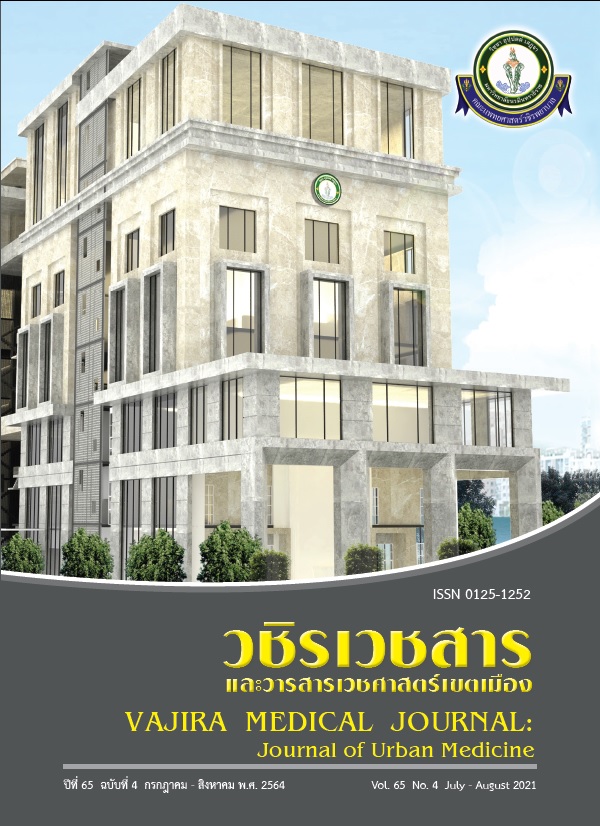Prevalence and Factors Associated with adverse outcomes in discharged patients with community-acquired pneumonia at the emergency department, Vajira hospital.
Main Article Content
Abstract
Objective: This study has objectives to study the prevalence and factors associated with adverse outcomes in discharged patients with community-acquired pneumonia (CAP) at the emergency department, Vajira hospital.
Method: This was a retrospective chart review from January to December 2014. Medical records of over 14-year-old CAP patients who were diagnosed and discharged at emergency department were reviewed in 130 records. The severity was categorized according to CRB-65. We analyzed factors that correlate to adverse outcomes.
Results: Prevalence of adverse outcomes in discharged patients with CAP was 24 (18.5%). Eighteen of 24 (12.3%) revisited in outpatient clinic and six of 24 (6.2%) needed admission. Ten of 24 (7.7%) had adverse events within 72 hours. The factors that significantly related to adverse outcomes in patients with CAP were the severity at first ED presentation (p< 0.01) and chronic obstructive pulmonary disease (COPD) (p= 0.023).
Conclusion: The factors associated to adverse outcomes in discharged CAP patients are moderate severity of CAP and COPD. The CAP patients who has either one of these factors need more assessment and close follow up.
Downloads
Article Details

This work is licensed under a Creative Commons Attribution-NonCommercial-NoDerivatives 4.0 International License.
References
Udompanit W. Guidelines for the treatment of community pneumonia in Thailand (For adults). Bangkok: The Uravej Association of Thailand; 2001.
Kaewnok W. Pneumonia. Weekly Epidemiological Surveillance Report 2012; 43: 90-8.
Welte T. Risk factors and severity scores in hospitalized patients with community-acquired pneumonia: prediction of severity and mortality. Eur J Clin Microbiol Infect Dis 2012; 31: 33–47.
Mandell LA, Bartlett JG, Dowell SF, File TM Jr, Musher DM, Whitney C. Update of practice guidelines for the management of communityacquired pneumonia in immunocompetentadults. Clin Infect Dis 2003; 37(11):1405–33.
Lode HM. Managing community-acquired pneumonia: a European perspective. Respir Med 2007; 101(9):1864–73.
Lim WS, Baudouin SV, George RC, Hill AT, Jamieson C, Le Jeune I, et al. Pneumonia Guidelines Committee of the BTS Standards of Care Committee. BTS guidelines for the management of community acquired pneumonia in adults: update 2009. Thorax 2009 ;64 Suppl 3:1-55.
Mandell LA, Wunderink RG, Anzueto A, Bartlett JG, Campbell GD, Dean NC, et al. Infectious Diseases Society of America/American Thoracic Society consensus guidelines on the management of community-acquired pneumonia in adults. Clin Infect Dis 2007; 44 Suppl 2(Suppl 2):S27-72.
Ebell MH. Outpatient vs. inpatient treatment of community acquired pneumonia. Fam Pract Manag 2006;13(4):41-4.
Community-acquired pneumonia in adults in British hospitals in 1982-1983: a survey of aetiology, mortality, prognostic factors and outcome. The British Thoracic Society and the Public Health Laboratory Service. Q J Med 1987;62(239):195-220.
Lim WS, van der Eerden MM, Laing R, Boersma WG, Karalus N, Town GI, et al. Defining community acquired pneumonia severity on presentation to hospital: an international derivation and validation study. Thorax 2003;58(5):377-82.
Steel K, Gertman P, Crescenzi C, Anderson J. Latrogenic illness on a general medicine service at a university hospital. N Engl J Med 1981;304:638-42.
Minogue MF, Coley CM, Fine MJ, Marrie TJ, Kapoor WN, Singer DE. Patients hospitalized after initial outpatient treatment for communityacquired pneumonia. Ann Emerg Med 1998;31(3):376-80.
Schnoor M, Klante T, Beckmann M, Robra BP, Welte T et al. Risk factors for community-acquired pneumonia in German adults: the impact of children in the household. Epidemiol Infect 2007; 135(8):1389–97.


